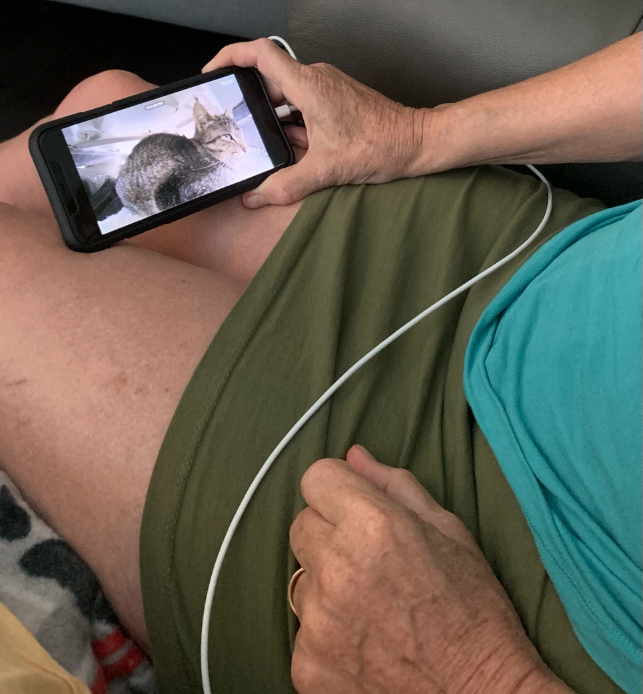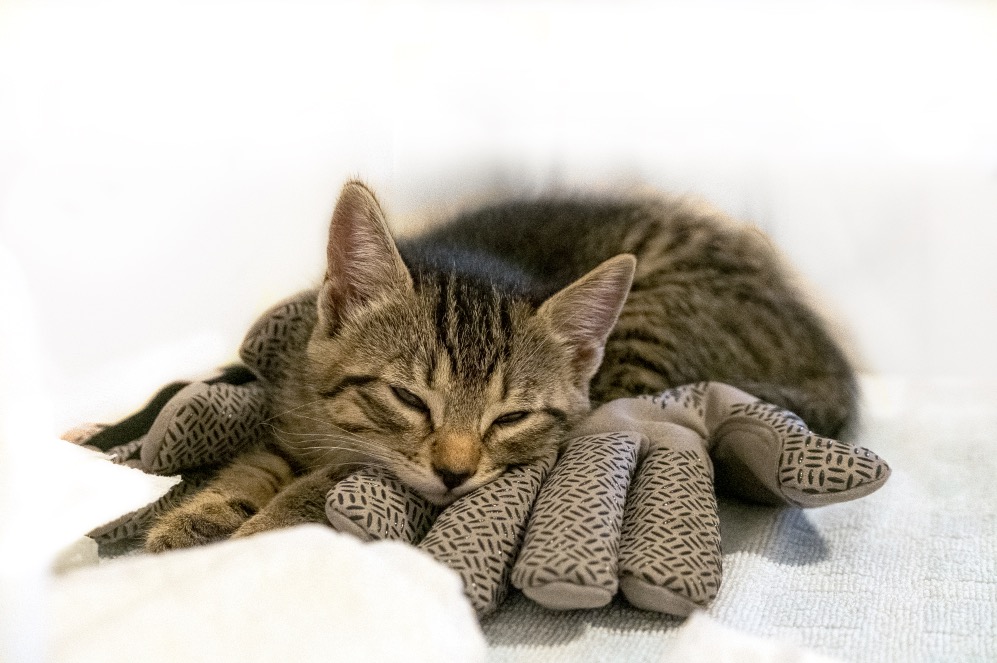July 2021
Some definitions found online
The definition of socialisation:
Socialisation is known as the process of inducting the individual into the social world. The term socialisation refers to the process of interaction through which the growing individual learns the habits, attitudes, values and beliefs of the social group into which he has been born.
General definition of domestication:
The process of taming an animal and keeping it as a pet or on a farm.
More specific for pets:
The domestication of animals is the mutual relationship between animals and the humans who have influence on their care and reproduction.
Mitsy started to develop some aggression towards us in the first weeks after delivering her litter. To be honest: it was quite frightening. We had naively romanticised about having her in the house as a well-adjusted and ideally cuddly companion. Even in our lap, but the only way that happened was as shown in the picture below…. through the joys of technology. Me looking at the live webcam on my phone, phone on lap, cat in lap 🙂

In reality Mitsy became more and more annoyed when we cleaned her litter box. It was right next to the carrier that was her ‘Nest’ and safe birthing shelter. Any time we opened the crate and got near it, she flew out, hissing, claws out, ears to the side and looking pretty frightening. You suddenly realise how vulnerable you are against an animal that is upset.
Fear rather than aggression
At first, neither of us saw this behaviour for what we now know it to be. She was annoyed, for sure, but mostly she was protective of her litter right ‘next door’ and… she was more afraid of us than we were of her! Some might even say that she mirrored the fear that we projected on her! Fear was what fueled her actions. And the fear got worse because we only did the cleaning with our bite-protection gloves on. This made our hands look even bigger than they must have already seemed to her. My movements were hesitant and jerky in the beginning. I did not know what to expect. Remember, this was a cat with a basically friendly nature, that however had never had any (positive) experiences with human touch or closeness.
An old trigger
For me there was something else at play too. I once trusted the owner of a mare with a new filly. She had invited a friend and myself to come and see the baby and who can say no to that, right? She let us into the paddock and stood talking with my friend as I stood there, mesmerised by the beautiful baby horse. The mare stayed with her owner, the filly was as curious about me as I was about her and walked towards me. I just stood there, bent down to her and stood upright again when I saw the shadow of the mare behind the filly. I was going to withdraw but it was too late. The mare attacked me and bit me in the cheek. It all went so fast that I was unable to keep myself safe. Weirdly enough, I remember the whole thing in slow motion! Suffice it to say that it to quite the injury and the experience has always stayed with me. I made a lot of mistakes that day. I did not know the horse, I should not have trusted its owner. I should have realised that even though I did not make any wrong moves, the mare was very protective of her filly that was barely 2 days old. I should not have let my fuzzy feelings towards the baby cloud my judgment or vision. I should not have let down my guard.
It truly influenced my behaviour towards Mitsy – I am much more cautious than I used to be…
Quiet voices and slow blinks
As long as Mitsy was crated and not more or less free, we really had very few opportunities to have friendly interactions with her so that she would learn that not every human represents danger. There was no question of ‘taming’ her, as stated in the above definitions. She was not our pet, at that time. She was a prisoner. We fed her, kept her ‘prison’ clean and the only repeating interaction we purposely worked on was to talk to her in a friendly voice and give her the ‘slow blink’: closing both eyes slowly while looking at her. When you observe cats interacting with other cats, you will see this slow blink when they like each other or try to put another cat at ease. It’s a way of saying: “Hi! Everything is good in the world. It’s all OK”.
We took baby steps in those early weeks. She did not blink back at us. She kept eye contact whenever we were near. We could tell that the whole situation was entirely new to her. Sounds in particular frightened her. We had a watering can with a narrow spout that was perfect to add kibble to her bowl. The sound of the kibble made her hiss and withdraw. The scent of it made her come out to eat, but only after we had left. The sound of the crate opening put her on high alert and sometimes we both doubted that we would ever be able to get close to this cat. So we focussed on keeping her in good health and keeping the litter safe. That was our main goal at that time. Get good homes for the kittens and worry about Mitsy after that was done.
Better safe than sorry…
I have to smile when I think back to those days. I remember the video I posted on the blog of how I fed her the very first day after her capture. There were no kittens yet. I had been told it would be best to take every possible precaution against being attacked and her escaping and as you now know, I had good personal reasons to do just that. Here was my first day routine:
Check where Mitsy is. If in the carrier, proceed. The door of the carrier was always open and it was fastened to the side of the crate with a clamp. So the next ste: take off the clamp and give the door a little nudge so that it blocked the carrier entrance. Then put on the bite-protection gloves. Take the clamps off the entrance of the crate, open it and lock the door of the carrier. As you can see and hear in the video below, this was not a silent process. All the time, you never even see Mitsy. She is hiding in the very back of the carrier, probably trembling with stress. With the door of the carrier locked, I did not have to worry about attacks or even attempts to escape. She was too scared to do such things. But better safe than sorry!
Nevertheless, I pretty quickly decided against locking the carrier at feeding time: I could keep an eye on her through the ventilation slits of the carrier and as long as she was in the back, there was no need to worry. And I learned to be quick. Replaced the litter box with a fresh one and did the same with the food bowls. It was a good thing to start with maximum protective measures – had she been more feral than she turned out to be. I was not interested in more injuries in my face or on my body…
No better way to show what cats, undamaged by humans, do with bite-protection gloves: Sipke sleeping right on top of those weird but soft things he found lying around in the cat room one day…
